Möchten Sie einen sicheren Ort, um mit Ihrer WordPress-Website zu experimentieren, ohne Angst haben zu müssen, etwas auf Ihrer Live-Site zu beschädigen?
Die Migration Ihrer WordPress-Website auf einen lokalen Server auf Ihrem Computer ist unserer Meinung nach die perfekte Lösung, insbesondere für Entwickler, Designer oder WordPress-Anfänger.
Die Installation von WordPress auf Ihrem Computer (lokaler Server) ermöglicht es Ihnen, WordPress einfach zu lernen und Dinge zu testen. Wenn Sie eine Live-WordPress-Site auf einen lokalen Server verschieben, können Sie mit denselben Daten wie auf Ihrer Live-Site experimentieren.
In diesem Artikel zeigen wir Ihnen, wie Sie eine Live-WordPress-Site einfach auf einen lokalen Server verschieben.
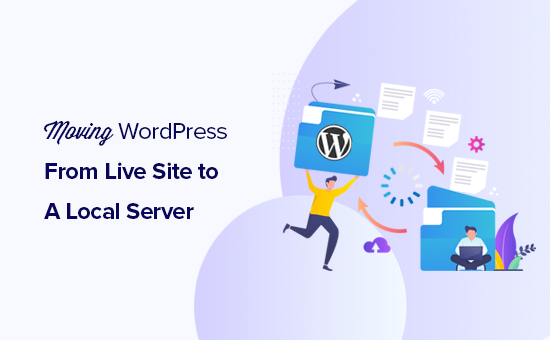
Warum und wer möchte eine Live-WordPress-Site auf einen lokalen Server verschieben?
Wenn Sie WordPress-Website schon seit einiger Zeit betreiben, möchten Sie vielleicht neue Themes oder ein Plugin ausprobieren. Dies auf einer Live-Website zu tun, kann jedoch zu einer schlechten Benutzererfahrung für Ihre Benutzer führen.
Um dies zu vermeiden, erstellen viele Benutzer eine Kopie ihrer WordPress-Website auf einem lokalen Server, um neue Themes, Plugins zu testen oder Entwicklungstests durchzuführen.
Dies ermöglicht es Ihnen, Ihr Theme mit all Ihren Inhalten einzurichten und alle Funktionen zu testen, ohne sich Gedanken über die Beschädigung Ihrer Website machen zu müssen. Viele Benutzer kopieren ihre Website auf einen lokalen Server, um ihre WordPress- und Programmierkenntnisse mit tatsächlichen Website-Daten zu üben.
Obwohl Sie alle Tests mit Dummy-Inhalten in WordPress durchführen können, liefern echte Website-Daten eine bessere visuelle Darstellung, wie diese Änderungen auf Ihrer Live-Website erscheinen werden.
Vorbereitung des Umzugs einer lokalen Website auf einen lokalen Server
Zuerst müssen Sie sicherstellen, dass Sie Ihre WordPress-Website immer sichern. Es gibt mehrere großartige WordPress-Backup-Plugins, die Sie verwenden können.
Zweitens müssen Sie eine lokale Serverumgebung auf Ihrem Computer installieren. Sie können WAMP für Windows und MAMP für Mac verwenden. Sobald Sie die Umgebung eingerichtet haben, müssen Sie eine neue Datenbank mit phpMyAdmin erstellen.
Besuchen Sie einfach die folgende URL in Ihrem Browser, um phpMyAdmin zu starten.
http://localhost/phpmyadmin/
http://localhost:8080/phpmyadmin/
Von hier aus müssen Sie auf die Registerkarte „Datenbanken“ klicken und eine neue Datenbank erstellen. Sie benötigen diese Datenbank später, um Ihre Live-Website-Daten zu entpacken.

Sie sind nun bereit, Ihre Live-WordPress-Site auf einen lokalen Server zu verschieben.
Methode 1. Live-WordPress-Site mit Plugin auf lokalen Server verschieben
Diese Methode ist einfacher und wird für alle Benutzer empfohlen.
Das Erste, was Sie tun müssen, ist, das Duplicator Plugin zu installieren und zu aktivieren. Weitere Details finden Sie in unserer Schritt-für-Schritt-Anleitung zum Installieren eines WordPress-Plugins.
Duplicator ermöglicht es Ihnen, einfach ein Duplikatpaket Ihrer gesamten Website zu erstellen. Es kann verwendet werden, um Ihre WordPress-Site an einen neuen Ort zu verschieben, und kann auch als Backup-Plugin verwendet werden.
Hinweis: Es gibt eine kostenlose Version von Duplicator, mit der Sie beginnen können. Duplicator Pro bietet jedoch unbegrenzte Backups und erweiterte Funktionen.
Nach der Aktivierung gehen Sie im Admin-Seitenmenü von WordPress zu Duplicator Pro » Backups. Um ein neues Paket zu erstellen, müssen Sie auf die Schaltfläche 'Neu hinzufügen' klicken.
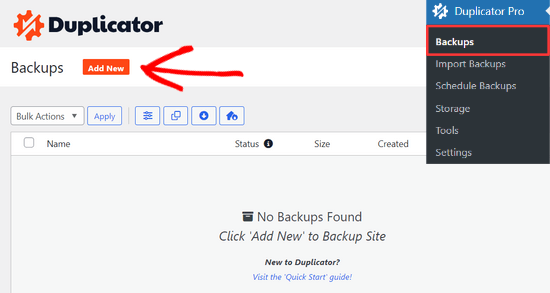
Duplicator startet dann den Backup-Assistenten.
Zuerst müssen Sie einen Namen für Ihr Backup-Paket eingeben. Sie können auch dynamische Tags verwenden, um automatisch ein Namensformat wie das Datum und den Titel Ihrer Website zu erstellen.

Erweitern Sie dann den Abschnitt „Speicher“ und wählen Sie einen Speicherort aus.
Für dieses Tutorial verwenden wir den Standardpfad. Sie können auf den Link „Speicher hinzufügen“ klicken, um einen neuen Speicherort hinzuzufügen, z. B. Dropbox oder Google Drive, wenn Sie möchten.
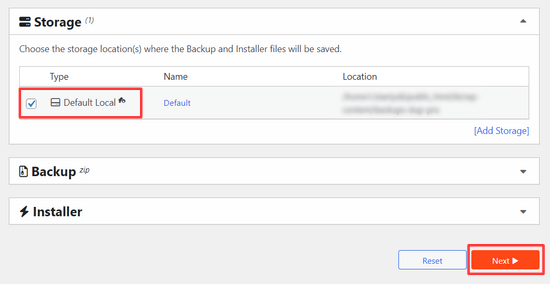
Klicken Sie auf die Schaltfläche „Weiter“, um fortzufahren.
Das Plugin scannt dann Ihre Website und führt einige Hintergrundprüfungen durch. Anschließend wird Ihnen eine Zusammenfassung dieser Prüfungen angezeigt.
Wenn alles gut aussieht, klicken Sie auf die Schaltfläche „Backup erstellen“, um fortzufahren.
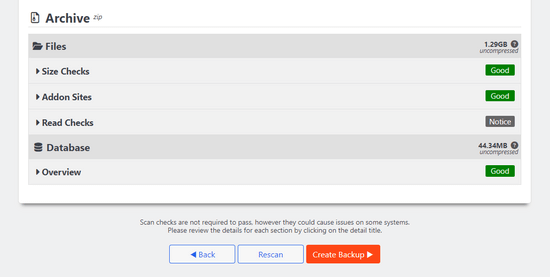
Duplicator wird nun Ihr Website-Paket erstellen.
Sobald Sie fertig sind, sehen Sie eine Archiv-Zip-Datei, die alle Ihre Website-Daten enthält, sowie eine Installationsdatei. Sie müssen beide Dateien auf Ihren Computer herunterladen.
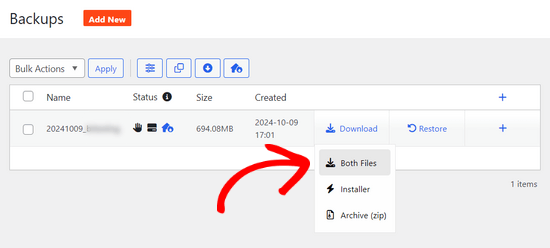
Sie sind nun bereit, diese Dateien auf Ihrem lokalen Server zu entpacken und zu installieren.
Zuerst musst du einen neuen Ordner im Stammordner deines lokalen Servers erstellen. Dies ist der Ordner, in dem dein lokaler Server alle Websites speichert.
Wenn Sie beispielsweise MAMP verwenden, ist dies der Ordner /Applications/MAMP/htdocs/. Alternativ, wenn Sie WAMP verwenden, wäre es der Ordner C:\wamp\www\.
Innerhalb dieses Ordners können Sie neue Ordner für jede neue Website erstellen, die Sie auf Ihrem lokalen Server importieren oder erstellen möchten.
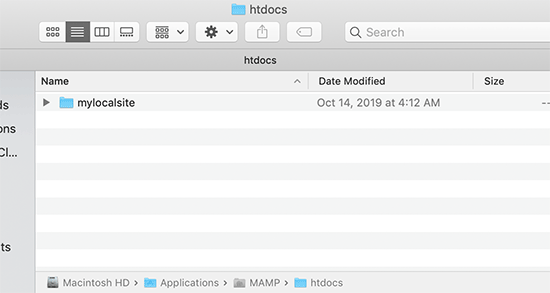
Danach müssen Sie den Ordner öffnen, den Sie für Ihre lokale Website erstellt haben, und dann sowohl die Archiv-ZIP-Datei als auch das zuvor heruntergeladene Installer-Skript kopieren und einfügen.
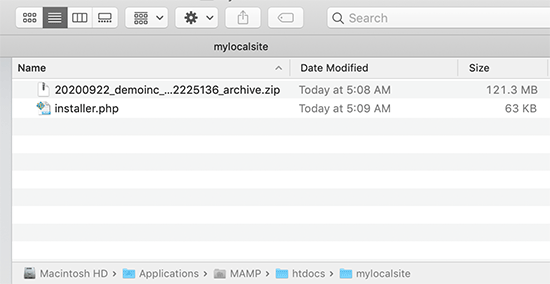
Um die Installation auszuführen, müssen Sie das Skript installer.php in Ihrem Webbrowser öffnen.
Wenn Sie beispielsweise beide Dateien in den Ordner /mylocalsite/ kopiert haben, greifen Sie über den Browser darauf zu, indem Sie http://localhost/mylocalsite/installer.php aufrufen.
Sie sehen nun das Duplicator-Installationsskript wie folgt:
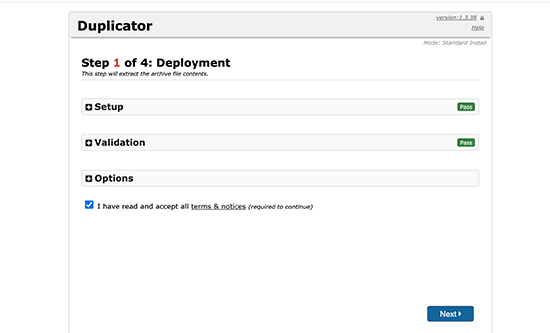
Klicken Sie auf die Schaltfläche „Weiter“, um fortzufahren.
Duplicator entpackt nun die Archiv-ZIP-Datei und fordert Sie auf, die Datenbankinformationen Ihrer lokalen Website einzugeben. Dies ist die zuvor erstellte Datenbank.
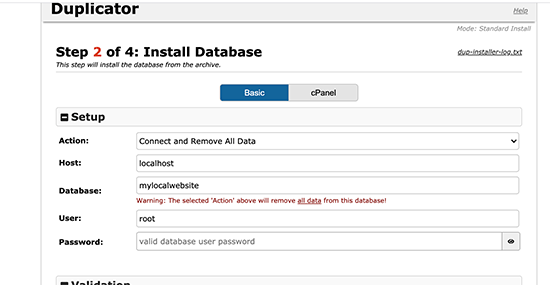
Der Servername ist fast immer localhost und der Benutzername ist root. In den meisten Fällen hat deine lokale Serverinstallation kein Passwort für root festgelegt, sodass du dieses Feld leer lassen kannst.
Unten auf der Seite siehst du eine Schaltfläche 'Datenbank testen', mit der du sicherstellen kannst, dass deine Datenbankinformationen korrekt sind.
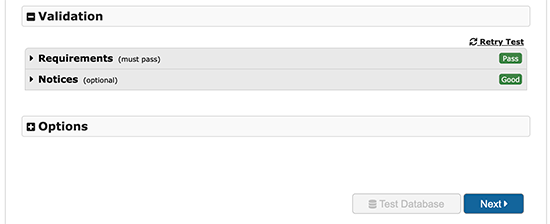
Wenn alles gut aussieht, klicken Sie auf die Schaltfläche „Weiter“, um fortzufahren.
Duplicator importiert nun Ihre WordPress-Datenbank. Danach werden Sie aufgefordert, die neuen Website-Informationen, die es automatisch erkannt hat, noch einmal zu überprüfen.
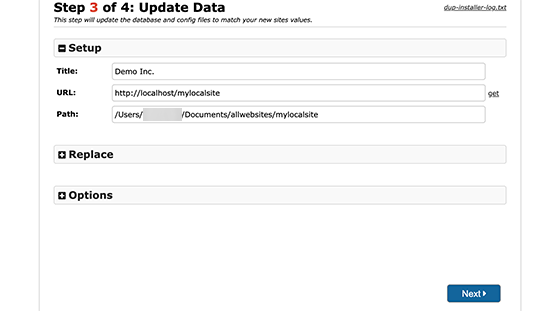
Klicken Sie auf die Schaltfläche „Weiter“, um fortzufahren.
Duplicator wird nun die Einrichtung abschließen und Ihnen eine Schaltfläche anzeigen, um sich bei Ihrer lokalen Website anzumelden. Sie verwenden denselben WordPress-Benutzernamen und dasselbe Passwort, das Sie auf Ihrer Live-Website verwenden.
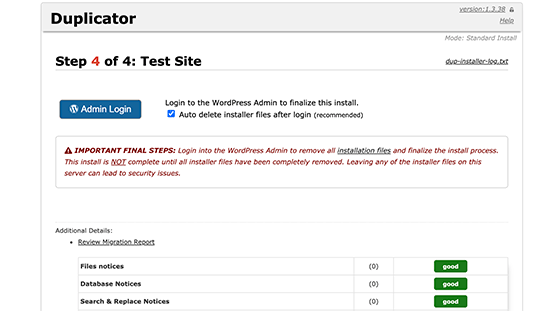
Das war's, Sie haben Ihre Live-Site erfolgreich auf einen lokalen Server verschoben.
Methode 2. Live-WordPress-Website manuell auf lokalen Server verschieben
Falls das Plugin nicht für Sie funktioniert, können Sie Ihre Live-Website jederzeit manuell auf einen lokalen Server verschieben. Das Erste, was Sie tun müssten, ist, Ihre Website manuell aus Ihrem WordPress-Hosting-Account zu sichern.
Schritt 1. Exportieren Sie die WordPress-Datenbank Ihrer Live-Website
Um die WordPress-Datenbank Ihrer Live-Website zu exportieren, müssen Sie sich in Ihr cPanel-Dashboard einloggen und auf phpMyAdmin klicken.
Hinweis: Wir zeigen Screenshots vom Bluehost Dashboard.
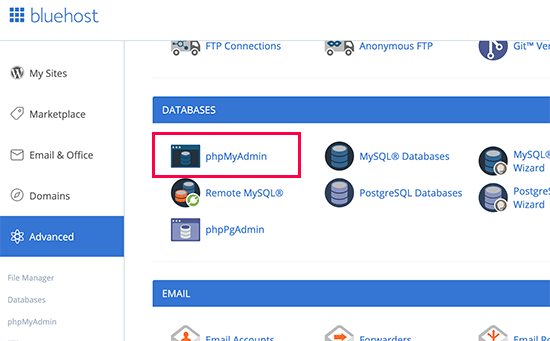
Innerhalb von phpMyAdmin müssen Sie die zu exportierende Datenbank auswählen und dann oben auf die Registerkarte „Export“ klicken.
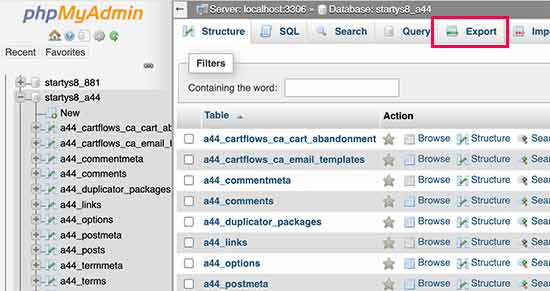
phpMyAdmin wird Sie nun auffordern, entweder die schnelle oder die benutzerdefinierte Exportmethode zu wählen. Wir empfehlen die benutzerdefinierte Methode und die Auswahl von ZIP als Komprimierungsmethode.
Manchmal können WordPress-Plugins eigene Tabellen in Ihrer WordPress-Datenbank erstellen. Wenn Sie dieses Plugin nicht mehr verwenden, können Sie mit der benutzerdefinierten Methode diese Tabellen ausschließen.
Lassen Sie die restlichen Optionen unverändert und klicken Sie auf die Schaltfläche „Go“, um Ihr Datenbank-Backup im Zip-Format herunterzuladen.
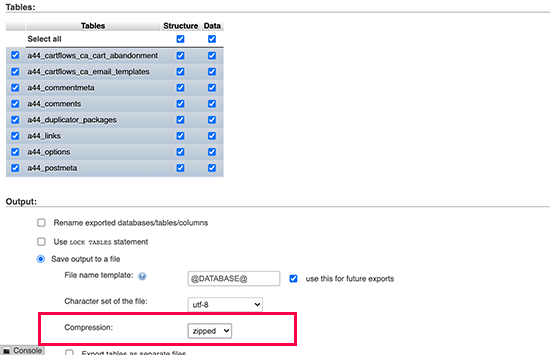
phpMyAdmin wird nun Ihre Datenbankdatei herunterladen. Weitere Details finden Sie in unserem Tutorial zum Thema Sichern Ihrer WordPress-Datenbank manuell.
Schritt 2. Laden Sie alle Ihre WordPress-Dateien herunter
Der nächste Schritt ist das Herunterladen Ihrer WordPress-Dateien. Dazu müssen Sie sich mit Ihrer WordPress-Site über einen FTP-Client verbinden.
Wählen Sie nach der Verbindung alle Ihre WordPress-Dateien aus und laden Sie sie auf Ihren Computer herunter.
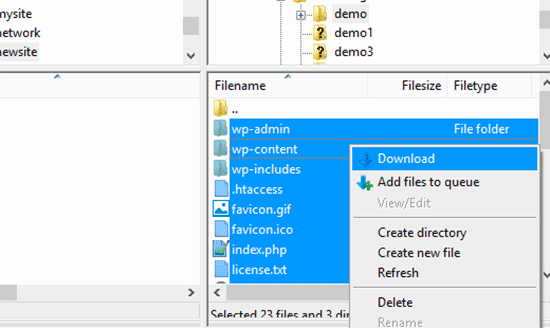
Schritt 3. Importieren Sie Ihre WordPress-Dateien und -Datenbank auf den lokalen Server
Nach dem Herunterladen Ihrer WordPress-Dateien müssen Sie auf Ihrem lokalen Server einen Ordner erstellen, in den Sie die lokale Website importieren möchten.
Wenn Sie WAMP verwenden, erstellen Sie einen Ordner innerhalb des Ordners C:\wamp\www\ für Ihre lokale Website. MAMP-Benutzer müssen einen Ordner im Ordner /Applications/MAMP/htdocs/ erstellen.
Kopieren und fügen Sie danach einfach Ihre WordPress-Dateien in den neuen Ordner ein.
Als Nächstes müssen Sie Ihre WordPress-Datenbank importieren. Öffnen Sie einfach phpMyAdmin auf Ihrem lokalen Server, indem Sie die folgende URL aufrufen:
http://localhost/phpmyadmin/
Da Sie die Datenbank bereits zuvor erstellt haben, müssen Sie sie nun auswählen und dann oben auf die Registerkarte „Importieren“ klicken.
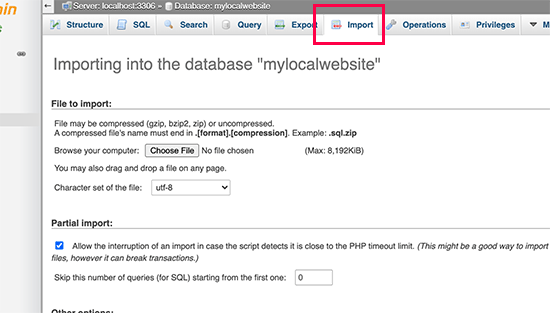
Klicken Sie auf die Schaltfläche „Datei auswählen“, um die Datenbank-Exportdatei auszuwählen und hochzuladen, die Sie im ersten Schritt heruntergeladen haben. Klicken Sie danach auf die Schaltfläche „Los“ am Ende der Seite.
phpMyAdmin wird nun Ihre WordPress-Datenbank entpacken und importieren.
Jetzt, da Ihre Datenbank eingerichtet ist, müssen Sie die URLs in Ihrer WordPress-Datenbank aktualisieren, die auf Ihre Live-Site verweisen.
Sie können dies tun, indem Sie eine SQL-Abfrage in phpMyAdmin ausführen. Stellen Sie sicher, dass Sie die Datenbank Ihrer lokalen Website ausgewählt haben und klicken Sie dann auf SQL.
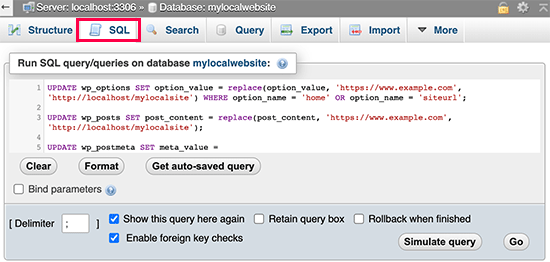
Kopieren Sie diesen Code auf dem SQL-Bildschirm von phpMyAdmin und fügen Sie ihn ein. Stellen Sie sicher, dass Sie example.com durch die URL Ihrer Live-Site und http://localhost/mylocalsite durch die URL Ihres lokalen Servers ersetzen.
UPDATE wp_options SET option_value = replace(option_value, 'https://www.example.com', 'http://localhost/mylocalsite') WHERE option_name = 'home' OR option_name = 'siteurl'; UPDATE wp_posts SET post_content = replace(post_content, 'https://www.example.com', 'http://localhost/mylocalsite'); UPDATE wp_postmeta SET meta_value = replace(meta_value,'https://www.example.com','http://localhost/mylocalsite');
Diese Abfrage ersetzt Referenzen der URL Ihrer Live-Site in der Datenbank und ersetzt sie durch die localhost-URL.
Schritt 4. Aktualisieren Sie die Datei wp-config.php
Der letzte Schritt ist die Aktualisierung der wp-config.php-Datei Ihrer lokalen Website. Diese Datei enthält WordPress-Einstellungen, einschließlich der Verbindung zu Ihrer WordPress-Datenbank.
Gehen Sie einfach zu dem Ordner, in dem Sie WordPress auf Ihrem lokalen Server installiert haben, und öffnen Sie dann die Datei wp-config.php in einem Texteditor wie Notepad.
Ersetzen Sie den Datenbanknamen durch den, den Sie in phpMyAdmin auf Ihrem lokalen Host erstellt haben.
Ersetzen Sie danach den Datenbankbenutzernamen durch Ihren lokalen MySQL-Benutzernamen, normalerweise ist dies root. Wenn Sie ein Passwort für den MySQL-Benutzer root auf Ihrem lokalen Host festgelegt haben, geben Sie dieses Passwort ein. Andernfalls lassen Sie es leer und speichern Sie Ihre Änderungen.
/** The name of the database for WordPress */
define('DB_NAME', 'database_name_here');
/** MySQL database username */
define('DB_USER', 'username_here');
/** MySQL database password */
define('DB_PASSWORD', 'password_here');
Sie können Ihre lokale Website jetzt in einem Browserfenster besuchen, indem Sie die URL wie folgt eingeben:
http://localhost/mylocalsite/
Ersetzen Sie 'mylocalsite' durch den Namen des Ordners, in den Sie Ihre WordPress-Dateien kopiert haben.
Das ist alles, Ihre Live-WordPress-Website wurde nun auf Ihren lokalen Server kopiert.
Wir hoffen, dieser Artikel hat Ihnen geholfen zu lernen, wie Sie eine Live-WordPress-Site einfach auf einen lokalen Server verschieben. Möglicherweise möchten Sie auch unseren Leitfaden lesen, wie Sie ganz einfach eine Staging-Site für WordPress erstellen zum Testen, oder wie Sie eine WordPress-Site von einem lokalen Server auf eine Live-Site verschieben.
Wenn Ihnen dieser Artikel gefallen hat, abonnieren Sie bitte unseren YouTube-Kanal für WordPress-Video-Tutorials. Sie finden uns auch auf Twitter und Facebook.





Reese
Hallo,
Ich erhalte eine Fehlermeldung, wenn ich diesen Schritt erreiche:
„Nachdem Ihre Datenbank eingerichtet ist, müssen Sie die URLs in Ihrer WordPress-Datenbank aktualisieren, die auf Ihre Live-Site verweisen. Sie können dies tun, indem Sie eine SQL-Abfrage in phpMyAdmin ausführen. Stellen Sie sicher, dass Sie die Datenbank Ihrer lokalen Site ausgewählt haben und klicken Sie dann auf SQL. Kopieren Sie im SQL-Bildschirm von phpMyAdmin diesen Code und fügen Sie ihn ein. Stellen Sie sicher, dass Sie example.com durch die URL Ihrer Live-Site und localhost/test-site durch die URL Ihres lokalen Servers ersetzen.“
Der Fehler lautet:
#1146 – Tabelle „rpd.wp_options“ existiert nicht
Bitte um Rat, danke!
Martin
Vielen Dank für all Ihre harte Arbeit. Ich bin ein Webentwickler-Anfänger und Ihre Website ist unglaublich hilfreich.
Ich habe mir beide Ihrer Artikel über die Migration von lokal zu live und umgekehrt angesehen. Ich habe eine WordPress-Website lokal erstellt und sie verwendet, um eine bestehende HTML-Website zu ersetzen. Dann habe ich Änderungen an der Live-Website vorgenommen und bin mir nicht ganz sicher, wie ich sie wieder „synchronisieren“ soll. Was würden Sie vorschlagen?
WPBeginner Support
Hallo Martin,
Bitte werfen Sie einen Blick auf unseren Leitfaden zum Einrichten einer Staging-Umgebung.
Admin
James
Vielen Dank für den Artikel, aber ich habe immer noch Probleme.
Eine Sache verstehe ich nicht: Sie beginnen damit, die Verwendung von BackupBuddy zu empfehlen (was ich zum Sichern meiner Websites verwende), sagen dann aber plötzlich, ich solle dieses Duplicator-Plugin verwenden.
Ich habe mein vollständiges Backup (mit DB) als ZIP meiner WordPress-Site, das ich mit BackupBuddy erstellt habe, und habe es in einen eigenen Ordner im „www“-Ordner in WAMP entpackt.
Ich habe erfolgreich eine neue DB in PhpMyAdmin erstellt und dann erfolgreich meine Website-DB darin importiert. Ich habe auch den DB-Namen und das Passwort in config.php geändert.
Beim nächsten Schritt, wenn ich versuche, die URLs zu ändern, kommt Folgendes zurück:
#1146 – Tabelle ‘zexico.wp_options’ existiert nicht
#1146 – Tabelle ‘zexico.wp_posts’ existiert nicht
#1146 – Tabelle ‘zexico.wp_postmeta’ existiert nicht
Was habe ich falsch gemacht?
danke
Ozi Diptongo
Hallo. Ich bekomme denselben Fehler. Konnten Sie ihn beheben? Danke!
Nina Chang
Aufbauend auf meinem früheren Kommentar – ich habe das Problem behoben! Aus irgendeinem Grund hat das Duplizierung-Plugin nicht alle meine Datenbanktabellen kopiert, was die erste Problemrunde verursacht hat – das habe ich gelöst, indem ich auf die manuelle Methode umgestiegen bin. Dann, als ich die Abfragen in MySQL ausgeführt habe, habe ich zunächst nicht bemerkt, dass ich auch die Namen der Datenbanktabellen ändern musste (d. h. ich habe einfach wp_options eingefügt, wenn ich das anpassen musste) – ich bin mir nicht sicher, ob das normal ist, da Ihre Codezeilen nur die URLs als korrekturwürdig hervorheben? DANN musste ich mich mit meiner seltsamen wp-config.php-Datei auseinandersetzen, in der alle Felder 'database', 'host', 'username' bereits ausgefüllt waren – nachdem ich beide Optionen ausprobiert hatte, funktionierte es nur, als ich die von WordPress bereits ausgefüllten Daten löschte und sie durch die localhost-Daten ersetzte, wie angewiesen. Ich verstehe nicht, warum meine wp-config-Datei bereits ausgefüllte Felder hatte, aber ich bin ein absoluter Neuling in all dem, also habe ich wahrscheinlich vieles übersehen/missverstanden. Trotzdem – vielen Dank nochmals für das Tutorial, es hat mich ENDLICH ans Ziel gebracht!
Nina Chang
Hallo,
Danke für das Tutorial. Ich habe versucht, meine Website mit Duplicator zu migrieren, und es scheint zu funktionieren, außer dass ich mich dann nicht in meine lokal gehostete Website einloggen kann – sie erkennt meinen Benutzernamen überhaupt nicht. Nachdem Duplicator meine Dateien installiert hatte, hatte ich zwei config.php-Dateien – eine config-sample.php und eine config.php, und auch zwei htaccess-Dateien – eine .htaccess und eine ORIG – könnten diese doppelten Dateien etwas mit meinen Login-Problemen zu tun haben? Ich habe jede Variation des Löschens eines Paares ausprobiert und auch versucht, meine wp-login-Datei zu ersetzen und Plugins zu löschen, wie ich anderswo gelesen habe, dass dies helfen könnte, aber nichts hat funktioniert. Ich habe den gesamten Prozess vom Packen neu gemacht und immer noch kein Glück! Ich habe es auch manuell versucht, bin aber bei den MySQL-Query-Updates stecken geblieben. Haben Sie eine Idee, wo ich falsch gelegen habe??
Vielen Dank!
Nina
Susan Taunton
Ich kann Ihnen gar nicht sagen, wie dankbar ich für diese Informationen bin. Ich habe unglaublich viel Zeit damit verbracht, eine Live-Website auf meinen lokalen Server zu übertragen, ohne Erfolg – und dann habe ich heute Ihren Beitrag gefunden. Habe den Duplicator benutzt und es hat FUNKTIONIERT!
DANKE!!!!!!!!! :-))
Redaktion
You’re very welcome Susan
Admin
Dilip Pradhan
Ich habe die Website von der Hosting-Domain auf den lokalen Host kopiert. Alles ist in Ordnung, aber alle Links im Menü und so weiter werden umgeleitet zu
Wie löse ich das?
Byron Allen
Hallo,
Ich hatte das gleiche Problem und habe gerade die Lösung gefunden. Ich bin sicher, Sie haben es inzwischen gelöst, aber das könnte anderen in Zukunft helfen.
Gehen Sie im WordPress-Adminbereich zu Einstellungen -> Permalinks. Wählen Sie "Beitragsname".
Ihre Probleme sollten gelöst sein.
John Payne
Danke für all die ausgezeichneten Ratschläge, die Sie geben – es ist ein wunderbarer Dienst für die WordPress-Community.
Ich benutze jetzt das All-in-1 WP Migration Plugin, um meine Website einfach zu sichern und sie bei Bedarf später zu migrieren.
Es wäre auch gut, Änderungen an den Websites auf meinem eigenen Computer vornehmen zu können und sie zu überprüfen, bevor aktualisierte Dateien hochgeladen werden.
Ich installiere XAMPP auf meinem Computer. Gibt es eine einfache Möglichkeit, meine All-in-1 WP Migration-Backup-Dateien damit zu verwenden?
Jeder Rat wird sehr geschätzt.
WPBeginner Support
Hallo John,
Entschuldigung, aber wir haben dieses Plugin nicht getestet. Bitte versuchen Sie, die Entwickler des Plugins zu kontaktieren.
Admin
Andres
Tolles Tutorial. Es ist wichtig zu erwähnen, dass Sie die HTACCESS-Datei löschen müssen, damit dies funktioniert.
Danke
James Orr
Von der lokalen Seite?
Siddhartha
Ja, vom lokalen Website-Ordner. Das habe ich gemacht, und meine Website funktionierte. Allerdings gibt es viele andere Probleme, mit denen ich auch jetzt noch zu kämpfen habe. Zum Beispiel funktionieren meine Kategorie-Links überhaupt nicht.
lohith
Tolles, sauberes Tutorial, meins hat ohne Probleme funktioniert.
Gokiko
Hallo WPbeginner,
Ich habe alle Anweisungen für die manuelle Verschiebung befolgt. Aber ich erhalte die Fehlermeldung „Hoppla! Diese Seite kann nicht gefunden werden.“ auf der Hauptseite, kein Inhalt kann angezeigt werden. Und alle Links auf meiner lokalen Website leiten zu meiner Online-Website.
Es scheint, dass nur die Hauptstruktur meiner Website (Theme, Menüs usw.) verschoben wurde, aber alles andere ist verloren gegangen.
WPBeginner Support
Wird dieser Fehler mit Ihrem WordPress-Theme oder auf einer leeren weißen Seite angezeigt? Wenn er auf einer leeren weißen Seite angezeigt wird, bedeutet dies wahrscheinlich, dass Ihre WordPress-Site nicht unter der URL installiert ist, die Sie versuchen.
Admin
Gokiko
Es wird in meinem WordPress-Theme angezeigt. Es zeigt auch alle meine Menüs und Inhaltskategorien an. Aber alle Links führen zur Adresse der Originalwebsite. Hier ist ein Screenshot, falls er hilft:
WPBeginner Support
Versuchen Sie, die Permalink-Struktur Ihrer Website zu aktualisieren. Gehen Sie zur Seite Einstellungen » Permalinks und klicken Sie auf die Schaltfläche Änderungen speichern, ohne Änderungen vorzunehmen.
Juan
Ich habe genau das gleiche Problem, aber ich kann mich nicht in meinen lokalen Host einloggen, indem ich wp-admin oder wp-login verwende, da es mich zur Live-Site-Domain weiterleitet.
Gibt es eine andere Möglichkeit, mich in meinen localhost/dev-site-Bereich einzuloggen, um diese Änderung vorzunehmen? Danke im Voraus!
Jason Hess
Sehr geehrte WPBeginner,
Zuerst einmal vielen Dank für alles, was Sie für die WP-Community tun. Meine Frage ist hoffentlich eine ziemlich einfache. (Berühmte letzte Worte, oder?) Derzeit verwende ich CLEF, um mich auf meiner "Live-Site" anzumelden. Wenn ich meine Live-Site auf meinen lokalen Server verschiebe, wird dies Probleme beim Versuch, mich auf der lokalen Seite anzumelden, nachdem der Umzug abgeschlossen ist, verursachen? Oder muss ich ein neues Anmelde-PW für meine Seite über das Dashboard auf meiner Live-Site erstellen, bevor ich den Umzug in eine lokale Umgebung vornehme, oder funktioniert CLEF auf meinem "lokalen Server" weiterhin?
Haben Sie auch Gedanken zur Verwendung von CLEF zur Anmeldung? Ich benutze WP seit etwa 2 Jahren mal mehr, mal weniger und möchte einfach Ihre Meinung zu CLEF erfahren.
Vielen Dank im Voraus! Ihr seid spitze! Sobald ich meine Seite zum Laufen gebracht habe, können Sie darauf wetten, dass ich Ihre Seite jedem empfehlen werde, den ich kenne. Ich habe schon so viel von Ihrer Seite gelernt und bin erst seit 2, fast 3 Monaten Mitglied.
Einen schönen Tag noch,
Jason Hess
WPBeginner Support
Sie können Clef jederzeit deaktivieren, sobald Sie Ihre Website auf einen lokalen Server übertragen haben.
Admin
Mohd Amir
Ich habe das Passwort für Filezilla vergessen, daher konnte ich nicht alle Dateien der Live-Website herunterladen. Ich habe nur ein Backup des wp_content der Live-Website. Was kann ich jetzt für den lokalen Server tun?
maarja
Hallo,
Vielen Dank für Ihre hilfreichen Anweisungen. Nach langer Zeit habe ich endlich die Live-Seite auf meinem localhost mit dem Plugin zum Laufen gebracht, ABER aus irgendeinem Grund werden die Inhaltsseiten auf dem Server nicht gefunden – alle Informationen, Texte usw. sind im Backoffice vorhanden, werden aber im Frontoffice nicht angezeigt, außer der Startseite.
Haben Sie eine Idee, wo/warum das Problem auftreten könnte?
Vielen Dank im Voraus,
Maarja
WPBeginner Support
Versuchen Sie, die Schritte in unserem Anfängerleitfaden zur Fehlerbehebung bei WordPress-Fehlern zu befolgen.
Admin
Yellow Canary
Thank you very much I have done it manually… from a live server to localhost. With your instructions I have managed this for the first time. And I even know now how to do a SQL query in phpMyAdmin. I feel like a real pro!
I have done it manually… from a live server to localhost. With your instructions I have managed this for the first time. And I even know now how to do a SQL query in phpMyAdmin. I feel like a real pro!
amna
Hallo,
Ich habe alle Schritte befolgt, aber ich erhalte einen internen Serverfehler.
Ich bin in einem Schritt verwirrt, nachdem ich die Live-Site über FileZilla von GoDaddy Host heruntergeladen habe. Ich ersetze den WordPress-Ordner durch meinen Live-Site-Ordner, d.h.
C:/users/amna/wamp/www/wordpress/old folders
mit C:/users/amna/wamp/www/wordpress/mywebsite neue Ordner
Bitte helfen Sie mir, ich bin Anfänger
Debenkumar Naorem
Hallo WEBBIGINNER SUPPORT, ich habe die Anleitung für das Handbuch befolgt, es funktioniert sehr gut. Danke für solche Anleitungen, ich habe danach gesucht. Danke nochmals.
WPBeginner Support
Hallo Debenkumar, gern geschehen. Vergessen Sie nicht, uns auf Facebook für weitere WordPress-Tipps und Tutorials beizutreten.
Admin
Manish
Hallo! Danke für den Beitrag.
Ich habe die manuelle Anleitung befolgt und meine Website-URL durch localhost/name of blog ersetzt. Das Problem, mit dem ich konfrontiert bin, ist, dass keine Bilder auf meinem Blog geladen werden. Alle hochgeladenen Bilder sind im Upload-Ordner. Der Text ist absolut in Ordnung. Die Bild-URLs haben sich zu localhost geändert, aber sie werden nicht angezeigt.
Könnten Sie mir bitte dabei helfen?
deepthi
Hallo, ich habe die manuelle Prozedur befolgt, um meine WordPress-Website unter localhost mit XAMPP zu überprüfen. Ich habe die Site-URL, Home sowie wp-posts und wp-postmeta geändert. Das Problem ist, dass meine Homepage unter localhost einwandfrei geladen wird. Aber wenn ich die Seiten im Menü aufrufe, kommt folgender Fehler.
Objekt nicht gefunden!
Die angeforderte URL wurde auf diesem Server nicht gefunden. Der Link auf der verweisenden Seite scheint falsch oder veraltet zu sein. Bitte informieren Sie den Autor dieser Seite über den Fehler.
Wenn Sie der Meinung sind, dass es sich um einen Serverfehler handelt, wenden Sie sich bitte an den Webmaster.
Fehler 404
localhost
Apache/2.4.10 (Win32) OpenSSL/1.0.1i PHP/5.5.15
Ich habe mich im Dashboard angemeldet und kann alle Seiteninhalte im Bearbeitungsbereich sehen, aber auch von dort aus, wenn ich versuche, die Seite anzuzeigen, wird derselbe Fehler gemeldet.
Der URL-Pfad, den er verwendet, ist nur meine aktualisierteURL,
bitte antworten Sie mit der Lösung
WPBeginner Support
Gehen Sie zur Seite Einstellungen » Permalinks und klicken Sie auf die Schaltfläche „Änderungen speichern“, um Ihre Permalinks zu aktualisieren.
Admin
Joshua S.
Kann ich dich umarmen? Kann ich dich für immer lieben?
Ich hatte dasselbe Problem. Ich habe alles richtig gemacht, außer dass die Homepage geladen wurde, aber alle anderen Seitenlinks schienen kaputt zu sein (es wurde nur ein ungestaltetes Layout meiner localhost-Informationen angezeigt).
Aber wenn ich zu Einstellungen>Permalinks>Änderungen speichern gehe, wurden meine Links zurückgesetzt und jetzt kann ich auf meine verschiedenen Seiten zugreifen, sogar auf die neuen Seiten, die ich erstelle, seit ich meine Website auf den lokalen Host verschoben habe.
MAG ICH!
WPBeginner Support
Danke Joshua, wir freuen uns, dass Sie es hilfreich fanden. Sie können auch unseren YouTube-Kanal für WordPress-Videotutorials abonnieren.
Peter
Nachdem ich die Anweisungen zum manuellen Verschieben der Website befolgt hatte, wurde die Homepage auf localhost einwandfrei angezeigt, aber keiner der Links funktionierte. Auf der Seite unten stand: „Gehen Sie zu Einstellungen/Permalinks im WordPress-Dashboard und aktualisieren Sie die Permalinks, indem Sie zweimal auf Änderungen speichern klicken.“ Das hat es behoben.
Mohd Hasan
Ich habe Ihre Schritte befolgt, aber nur die Homepage funktioniert einwandfrei und keiner der Links funktioniert. Die angeforderte URL /akhdir3/category/health/ wurde auf diesem Server nicht gefunden.
Anes P A
Sehr geehrte/r Autor/in,
Ich habe Ihren Schritt ausprobiert. Aber das Problem ist, dass beim Laden einer Seite der localhost auf die Online-Site verweist und die Menülinks auf die Online-Website zeigen. Wie kann das gelöst werden?
Bitte geben Sie Bescheid.
Danke
Anes
Bhavana
Ich habe alle oben genannten Schritte manuell durchgeführt. Aber ich bekomme nicht die tatsächliche Website, die ich möchte. Dort erscheinen alle deinstallierten Plugins im Admin-Panel und das Theme ist auch uncustomized. Wo mache ich etwas falsch?
Justin
Ich versuche, Ihre Anweisungen für eine manuelle Verschiebung zu befolgen.
Wenn ich versuche, die Adresse der Live-Website durch meinen lokalen Host zu ersetzen, gibt mir SQL einen Syntaxfehler zurück.
#1064 – Sie haben einen Fehler in Ihrer SQL-Syntax; überprüfen Sie das Handbuch, das Ihrer MariaDB-Serverversion entspricht, um die richtige Syntax für ')' in Zeile 1 zu verwenden
Sind Sie sicher, dass der Code korrekt ist?
Justin
Habe mein eigenes Problem gelöst... irgendwie.
Aus irgendeinem Grund beginnen alle meine Tabellen mit wplm anstelle von nur wp (wp_options = wplm_options zum Beispiel). Das Aktualisieren des Codes, um nach dem richtigen Tabellennamen zu suchen, ermöglichte es dem Skript, ohne Fehler ausgeführt zu werden.
Aber….SQL meldet „# MySQL hat ein leeres Ergebnis-Set zurückgegeben (d. h. null Zeilen)“ und die Werte in der Tabelle wurden nicht aktualisiert. Ich musste die Links von Hand aktualisieren. In meinem Fall waren es nur 2 Werte in wplm_options, aber ich kann mir vorstellen, dass einige Leute viel mehr Links zu überprüfen haben.
Dennoch habe ich meine Website jetzt importiert, und die Arbeit mit Local Hosting ist ein notorisch verwirrender Prozess.
Vielen Dank für die klaren und einfachen Anweisungen!
Lloyd
Die Anweisungen für den Duplicaor Installer beginnen mit dieser Zeile:
„Ihre lokale Server-Site benötigt eine neue Datenbank, daher müssen Sie auf Ihrem lokalen Server mit phpMyAdmin eine Datenbank erstellen.“
Ist das Erstellen einer neuen Datenbank etwas Einfaches wie das Klicken auf eine Menüoption, oder ist es so komplex, dass es eine ausführliche Anleitung zur Erklärung erfordern würde?
Wenn ich phpMyAdmin auf Xampp untersuche, sehe ich unter dem Tab „Datenbanken“ nur eine Möglichkeit, die besagt:
„Datenbank erstellen:
(X) Keine Berechtigungen“
Gibt es ein Berechtigungsproblem, und wenn ja, wo kann ich diesen Parameter ändern?
Ich habe zwei Websites auf diesem lokalen Host, die ordnungsgemäß zu funktionieren scheinen, daher gehe ich davon aus, dass der lokale Host korrekt eingerichtet ist.
Vielen Dank für jede Hilfe oder Vorschläge,
Lloyd
Ashvani Kumar
Ich folge der manuellen Option, aber wenn ich zur Seite Datenbank importieren in phpMyAdmin gehe, beträgt die maximale Größe für den Datenbank-Upload (Max: 2.048 KiB), aber meine Datenbank-Backup-Größe beträgt 710 MB. Wie erhöhe ich dieses Limit, damit ich die Datenbank hochladen kann?
Danke
WPBeginner Support
Sie müssen das Dateiupload-Limit in PHP erhöhen. Sehen Sie sich unseren Leitfaden an so erhöhen Sie die maximale Dateiuploadgröße. und folgen Sie der php.ini-Methode
Admin
Abdul Aleem Mohammed
Hallo Ashvani,
Sie können die max_upload_size in der php.ini-Datei in Apache ändern.
Standardmäßig beträgt sie 2 MB, Sie können sie nach Belieben ändern.
Danke
Judy Williams
Ich versuche das mit Duplicator. Ich habe meine Website und das Installationsprogramm heruntergeladen. Ich habe eine Datenbank mit phpMyAdmin erstellt und bin bei dem Punkt angelangt: „Sie müssen die Paket- und Installationsdatei in einen leeren Ordner im Webverzeichnis Ihres lokalen Servers kopieren und einfügen“. Ich habe keine Ahnung, wie das geht! Ich habe Filezilla und XAMPP auf meinem Laptop installiert. Gibt es ein Tutorial, wie man einen leeren Ordner im Webverzeichnis meines lokalen Servers erstellt? Ich stecke jetzt fest. Danke
WPBeginner Support
Sie können einfach zum htdocs-Ordner auf Ihrem Computer gehen.
Admin
german
Ich habe die Dateien und die Datenbank kopiert, wenn ich versuche, auf meinen localhost/test-site zuzugreifen, werde ich zum Dashboard weitergeleitet. Irgendwelche Ideen, warum das passieren könnte?
miguel
Vielen Dank für das klare Tutorial.
Obwohl ich das Gegenteil getan habe (von localhost zu einem öffentlichen Server), dachte ich, dass das Umgekehrte genauso einfach wäre.
Wenn es jedoch um die Verbindung der Datenbank geht, bin ich ratlos. Ich habe die Einstellungen immer wieder überprüft, ohne eine Verbindung herstellen zu können.
Ich hatte sogar einige Probleme und wurde aus der Datenbank ausgesperrt, aber zum Glück konnte ich das beheben.
In meiner config.php-Datei habe ich den Benutzer auf "root" geändert, dann auf leer gelassen, den Benutzernamen vom öffentlichen Server verwendet und dasselbe mit dem Passwort. Ich habe den Datenbanknamen korrekt auf den localhost-Namen gesetzt.
Ich kann nicht erraten, was ich tun muss.
Wenn Sie mir eine Richtung geben könnten, wo ich als nächstes suchen soll, würde ich es sehr zu schätzen wissen.
Vielen Dank für Ihre Arbeit aus Liebe. Es ist großartig zu sehen, wie viele Menschen mit Wissen denen helfen, die nach Antworten suchen.
Daniel
Hi
Ich möchte das auch tun. Ist dieser Beitrag vor ein paar Jahren geschrieben worden, ist der Ansatz immer noch der gleiche oder gibt es andere Plugins oder Beiträge, die ich mir ansehen sollte?
Daniel
Beatrix K.
Hallo zusammen,
Just wondering (please bare with me as I am new at this) – if I need to have have my local site to work with on two different devices, say my desktop and my laptop, is there a way for the changes I make on one device to be updated on the other device? I just want to know if it is possible to work from two different devices on the same project and not have to redo all of my changes. Thanks in advance for any insight
B
Muniba
Ich bin verwirrt in dem Schritt, der sich auf Filezilla bezieht... wie lade ich meine WordPress-Website mit Filezilla herunter..??
german
Laden Sie FileZilla herunter, stellen Sie eine Verbindung zu Ihrem aktuellen Host, der Produktionsseite, über FileZilla her. Sobald Sie eine Verbindung haben, können Sie die Dateien in ein lokales Verzeichnis auf Ihrem Computer herunterladen.
Dee
Würden wir also mit CPanel zum Beispiel die zugehörige IP, unseren CPanel-Benutzer und das Passwort zusammen mit „21“ als Portwert verwenden? Wie kann ich nach dem Aufbau einer Verbindung mit dem Cpanel-Host die Dateien auf meinen lokalen Rechner übertragen, während die Live-Site erhalten bleibt? Im Wesentlichen, wie erstelle ich eine Duplikat, sodass die gleiche Website auf beiden Hosts vorhanden ist (eine zum Experimentieren und eine, die live bleibt)?
Dee
Nach erfolgreicher Übertragung von Dateien von Remote zu Lokal, gibt es eine einfache Möglichkeit, die Dateien auf den lokalen Server, auf dem wir WordPress installieren möchten, per Stapelkopie&einfügen (anstatt manuell einzeln) zu kopieren? Ich habe versucht, alle Dateien zum Kopieren auszuwählen, aber es gibt keine Kopierfunktion. Bitte helfen Sie!
assal0le
Ich möchte meine Live-WordPress-Site auf meinen lokalen WAMP-Server kopieren, nicht verschieben. Meine Frage ist, ob dadurch meine Live-WordPress-Site entfernt wird, wenn ich diesem Tutorial mit dem Duplicator-Plugin folge?
Thx
Diane Laidlaw
Nein, es kopiert es nur.
Ognatius Chironga
Vielen Dank!
Ich fand diesen Artikel hilfreich.
Ich hätte fast mit der Neuerstellung meiner Website begonnen.
Quy P
Ich habe es mehrmals getestet und versucht. Es funktioniert nicht, bis ich die .htaccess-Datei lokal lösche. Danke.
Andres
Vielen Dank.
Tobias
Wenn Sie ein Netzwerk von Websites betreiben, sollten Sie auch die Spalte Domain-URLs in der Tabelle wp_blogs aktualisieren.
lorenzo
Danke für dieses nützliche Tutorial. Ich muss meine WP-Seite manuell verschieben, aber wenn ich im Browser „http://localhost/phpmyadmin/“ eingebe, erscheint mein phpMyAdmin nicht. Muss ich es vielleicht installieren? Wie?
Vielen Dank…
Dave
In der wp-config.php-Datei muss ich auch die /**MySQL-Hostname */ ändern
/** MySQL-Hostname */
define(‘DB_HOST’, ‘localhost’);
auf localhost einstellen
nicola
Hallo,
ich folge deinen Schritten, aber der Admin-Login ist nicht sichtbar... Fehler 404 nicht gefunden. Die gesamte Website ist in meiner lokalen Installation gut. Wie kann ich mein Problem lösen?
abdelouahad
Ich habe alle Schritte ausgeführt, aber ich habe immer die Fehlerseite, ich weiß nicht warum, kann mir bitte jemand helfen
Paul Denver Sy
Vielen Dank dafür. Das hat mir fast eine Woche Qual erspart, um es auf meinem lokalen Rechner zum Laufen zu bringen.
Shilling
Habe alle Schritte nochmals überprüft und es scheint alles in Ordnung zu sein, aber ich erhalte diese Fehlermeldung, wenn ich die Website über meine lokale URL aufrufe:
Der Verbindungsversuch von Google Chrome zu localhost wurde abgelehnt. Die Website ist möglicherweise nicht erreichbar oder Ihr Netzwerk ist möglicherweise nicht richtig konfiguriert.
Ich glaube nicht, dass die Seite offline ist. Meine lokale URL wechselt automatisch zu http://localhost/wordpress-folder-name
wo ich denke, dass sie zu http://localhost:888/wordpress-folder-name gehen sollte
Ich hoffe, das ist ein offensichtlicher Hinweis. Ich bin neu hier und habe einfach keine Ahnung.
Jede Einsicht wäre sehr willkommen.
Ebert
This was the clearest tutorial I found which helped me to copy a site I started with iPage to my laptop under localhost. The database was not imported but created a new local copy of the server database. I copied the data tables into my new database and modified the sql commands to match the table names and everything ran smoothly.
I had to reuse the password I used on the live site with the local wordpress copy and I can now access and modify what I need to.
Thanks and you just got another new subscriber to this great site.
Also the post about BackWPup was very helpful as well. I tried to use Duplicator and it kept giving me error messages about permissions to create a backup folder on my machine. I used BackWPup and everything ran without a hitch. Thanks again!!
Eduardo Weidman Barijan
Der manuelle Prozess hat wie am Schnürchen funktioniert. Danke.
Alessio
Hallo Leute,
Ich versuche, den Localhost auf meinem Computer mit Linux Mint zu konfigurieren.
Ich habe bereits eine neue Datenbank eingerichtet und die Dateien per FTP in meinen lokalen WordPress-Ordner übertragen.
Jetzt habe ich die Datenbank importiert, aber wenn ich die Abfrage zum Ändern der Webadresse in eine lokale Adresse eingebe, erhalte ich die Meldung „# MySQL returned an empty result set (d. h. null Zeilen)“.
Wenn ich jetzt im Browser „localhost“ eingebe, werde ich zur Online-Website weitergeleitet…
Was soll ich tun?
Vielen Dank!
idriss
Hallo Allesio,
Haben Sie das Problem lösen können?
Ich habe das gleiche Problem. Wie haben Sie es gelöst?
Danke
Justin
Gleiches Problem hier.
SQL hat Schwierigkeiten, die Live-Site-URL durch die lokale Host-Adresse zu ersetzen.
Ohne die Aktualisierungen der Datenbank versucht WP, eine Verbindung zur Live-Website anstelle der lokalen Website herzustellen.
Hat einer von euch beiden Glück gehabt, das zu beheben?
Sam
Gehen Sie zu Ihrem localhost phpmyadmin und der Datenbank, die Sie für die Website verwenden. Klicken Sie auf wp_options und bearbeiten Sie siteurl und home. Ersetzen Sie die Live-URL durch: localhost/ Ihr-Ordnername-hier
Das sollte es tun.
Sam
Mike
Der erste Schritt hat bei mir funktioniert.
Aber wie kann ich localhost/test-site/wp-admin aufrufen? Ich erhalte eine Fehlermeldung:
Interner Serverfehler
Wenke Adam
Das Aktualisieren der wp-config.php-Datei der lokalen Website ist möglicherweise nicht der letzte Schritt in diesem Verfahren. Ich habe Ihre Anweisungen befolgt und nach einigen Versuchen funktionierte die öffentliche Website (zuerst hatte ich einen Tippfehler in den SQL-Abfragen und nichts geschah), aber ich konnte immer noch nicht auf wp-admin zugreifen.
Die Lösung war, die Tabelle wp_options in der Datenbank zu bearbeiten. Die erste Zeile enthielt die falsche URL. Ich habe dies behoben und schließlich funktionierte alles, sogar die Permalinks.
Danke für all diese sehr schönen und klaren Tutorials!
Tim
Ich poste das erneut, da es anscheinend verschwunden ist (zumindest auf meiner Seite). Daher entschuldige ich mich, falls es ein Doppelpost ist.
Ich erhalte eine Fehlermeldung beim Hochladen der Datenbank. Irgendwelche Ideen?
Danke
Tim
Wenn ich versuche, die Datenbank hochzuladen, erhalte ich einen roten Fehlerbildschirm. Ich kann Ihnen gerne einen Screenshot des Fehlers senden.
Danke
WPBeginner Support
Sicher, Sie können den Screenshot auf einem Cloud-Hosting-Dienst wie Dropbox hochladen und den Link als Antwort auf diesen Kommentar einfügen. Wir werden ihn uns dann ansehen und versuchen zu helfen.
Admin
Ian Hyndman
Den ganzen Tag habe ich versucht, diese Änderung vorzunehmen, ohne Erfolg!
Ich musste sogar WordPress auf meinem Testserver neu installieren. Ich war schon kurz davor aufzugeben, als ich darauf gestoßen bin. Meine andere Option war, manuell alles zu kopieren und einzufügen und alle gleichen Plugins, die auf meinem Host-Server aktiv sind, auf meinem Testserver zu installieren.
Als ich deinen Beitrag gelesen habe, war ich in 5 Minuten fertig :):)
Thank you for your tutorial, its just what I needed. !
Well Done
Alexandros
Zwei Tage lang versuche ich, diese Änderung alleine ohne Erfolg vorzunehmen!
Als ich deinen Beitrag gelesen habe, war ich in 5 Minuten fertig :):)
Thank you for everything !
Keep up the great work